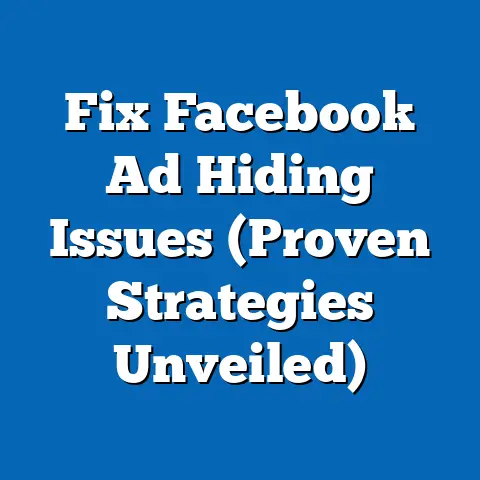Create a Privacy Policy for Facebook Ads (Essential Tool)
In today’s digital world, privacy isn’t just a buzzword – it’s a fundamental right, a competitive differentiator, and a legal imperative. As businesses increasingly leverage the power of Facebook advertising, the importance of a robust privacy policy cannot be overstated. I’ve seen firsthand how the evolution of data privacy laws, coupled with rising consumer awareness, has dramatically reshaped the landscape of online advertising. No longer can we afford to treat privacy as an afterthought; it must be a core component of our marketing strategies.
One myth I frequently encounter is the belief that a privacy policy is a “set it and forget it” document. Many businesses create a policy, post it on their website, and then never revisit it. This is a dangerous practice! Data privacy laws are constantly evolving, and consumer expectations are shifting just as quickly. What was compliant and transparent a year ago may be outdated and misleading today.
Another common misconception is that privacy policies are only necessary for large corporations. The truth is, regardless of your business size, if you’re collecting and using personal data through Facebook ads, you need a privacy policy. Failing to do so can expose you to significant legal penalties and damage your brand’s reputation.
The key takeaway here is that a privacy policy is not a static document. It’s a living, breathing reflection of your data practices, and it must be regularly reviewed and updated to stay compliant and maintain consumer trust. So, let’s get started on understanding how to create one that works for you.
Understanding Privacy Policies
At its core, a privacy policy is a statement that discloses how a business collects, uses, manages, and protects the personal information of its users. In the context of online advertising, particularly Facebook ads, this includes information gathered through website pixels, conversion tracking, custom audiences, and other data-driven targeting methods.
The purpose of a privacy policy is threefold:
- Legal Compliance: It ensures that your business adheres to relevant data privacy laws and regulations.
- Transparency: It provides users with clear and understandable information about how their data is being used.
- Trust Building: It demonstrates your commitment to protecting user privacy, which can enhance your brand’s reputation and foster stronger customer relationships.
Navigating the Legal Landscape
The legal requirements for privacy policies vary depending on your target audience and the jurisdictions in which you operate. However, some key regulations that commonly affect Facebook advertisers include:
- General Data Protection Regulation (GDPR): This European Union law applies to any business that collects or processes the personal data of EU residents, regardless of where the business is located. GDPR mandates that businesses obtain explicit consent from users before collecting their data, provide users with access to their data, and allow them to request deletion of their data.
- California Consumer Privacy Act (CCPA): This California law grants consumers the right to know what personal information businesses collect about them, the right to delete their personal information, and the right to opt-out of the sale of their personal information.
- Other State and National Laws: Many other states and countries have enacted or are considering similar data privacy laws. It’s essential to stay informed about the regulations that apply to your specific business.
I’ve seen businesses get caught off guard by these regulations, leading to hefty fines and reputational damage. One client of mine, a small e-commerce business, was fined under GDPR because they were using retargeting ads without obtaining explicit consent from EU residents. The cost of non-compliance can be substantial, making it imperative to prioritize data privacy.
Transparency: The Cornerstone of Trust
In today’s digital age, consumers are increasingly concerned about their privacy. They want to know how their data is being used, and they want to have control over it. A well-crafted privacy policy can help build trust with your audience by demonstrating your commitment to transparency.
When writing your privacy policy, avoid using jargon or complex legal language. Instead, use clear, concise language that is easy for the average person to understand. Be upfront about the types of data you collect, how you use it, and who you share it with.
For example, instead of saying “We collect personally identifiable information,” you could say “We collect your name, email address, and phone number when you sign up for our newsletter.” The more transparent you are, the more likely you are to build trust with your audience.
Key Takeaway: A privacy policy is not just a legal requirement; it’s an opportunity to build trust with your audience. By being transparent about your data practices, you can enhance your brand’s reputation and foster stronger customer relationships.
Key Components of a Privacy Policy
Now that we’ve established the importance of privacy policies, let’s delve into the essential elements that every Facebook advertiser should include.
1. Collection of Data
This section should clearly explain what types of data you collect through your Facebook advertising efforts. This includes:
- Personal Information: This includes data that can be used to identify an individual, such as their name, email address, phone number, and postal address.
- Demographic Information: This includes data about a user’s age, gender, location, and interests.
- Behavioral Information: This includes data about a user’s online activity, such as the websites they visit, the products they view, and the ads they click on.
- Device Information: This includes data about the device a user is using to access your website or app, such as the device type, operating system, and IP address.
- Cookies and Tracking Data: Explain how you use cookies, pixels, and other tracking technologies to collect data about users.
Be specific about the sources of this data. Are you collecting it directly from users through lead forms? Are you using the Facebook pixel to track website visitors? Are you using custom audiences based on customer lists?
2. Purpose of Data Usage
This section should clearly explain how you use the data you collect. This includes:
- Targeting: Explain how you use data to target your ads to specific audiences. For example, you might use demographic information to target ads to women aged 25-34 who are interested in fashion.
- Analytics: Explain how you use data to measure the performance of your ads and track conversions. For example, you might use the Facebook pixel to track how many people who click on your ads end up making a purchase.
- Retargeting: Explain how you use data to retarget users who have previously interacted with your website or ads. For example, you might retarget users who have visited a product page but haven’t added the product to their cart.
- Personalization: Explain how you use data to personalize the user experience. For example, you might use data about a user’s past purchases to recommend similar products.
I always emphasize to my clients the importance of being transparent about the purpose of data usage. Don’t bury this information in legal jargon. Be clear and concise about how you’re using data to improve your advertising efforts and provide a better experience for your users.
3. Data Sharing Practices
This section should disclose whether you share user data with any third parties. This includes:
- Facebook: Explain that you share data with Facebook for advertising purposes.
- Advertising Partners: If you work with any other advertising partners, disclose that you share data with them.
- Service Providers: If you use any third-party service providers to process user data (e.g., email marketing platforms, analytics providers), disclose that you share data with them.
- Legal Requirements: Explain that you may be required to disclose user data to comply with legal requirements.
Be upfront about the types of data you share and the reasons for sharing it. If you’re sharing data with Facebook for advertising purposes, explain that this allows you to target your ads more effectively and measure their performance.
4. User Rights
This section should outline the rights that users have regarding their data. This includes:
- Access: Users have the right to access the personal data that you hold about them.
- Deletion: Users have the right to request that you delete their personal data.
- Opt-Out: Users have the right to opt-out of the collection or use of their personal data for certain purposes, such as targeted advertising.
- Correction: Users have the right to correct any inaccuracies in their personal data.
- Data Portability: Users have the right to receive their personal data in a portable format.
Make it easy for users to exercise these rights. Provide clear instructions on how they can access their data, request deletion, opt-out of targeted advertising, and correct any inaccuracies.
5. Security Measures
This section should briefly explain the measures you take to protect user data from unauthorized access, use, or disclosure. This includes:
- Encryption: Explain that you use encryption to protect data in transit and at rest.
- Access Controls: Explain that you restrict access to user data to authorized personnel only.
- Security Audits: Explain that you conduct regular security audits to identify and address vulnerabilities.
- Data Breach Response Plan: Explain that you have a plan in place to respond to data breaches.
While you don’t need to provide a detailed technical explanation of your security measures, you should reassure users that you take their data security seriously.
6. Contact Information
This section should provide clear contact information for users who have questions or concerns about your privacy policy. This includes:
- Email Address: Provide an email address that users can use to contact you with privacy-related inquiries.
- Postal Address: Provide a postal address that users can use to send written inquiries.
- Phone Number: Provide a phone number that users can call with privacy-related inquiries.
Make sure that you respond to privacy-related inquiries promptly and professionally. This will demonstrate your commitment to transparency and help build trust with your audience.
Key Takeaway: A comprehensive privacy policy should clearly explain what data you collect, how you use it, who you share it with, what rights users have, what security measures you take, and how users can contact you with questions or concerns.
Crafting a Privacy Policy for Facebook Ads
Now that you understand the key components of a privacy policy, let’s walk through the process of crafting one specifically for your Facebook advertising efforts.
Step 1: Identify the Data You Collect
The first step is to create a comprehensive list of all the data you collect through your Facebook ads. This includes:
- Data Collected Through the Facebook Pixel: This includes data about website visitors, such as the pages they visit, the products they view, and the actions they take.
- Data Collected Through Conversion Tracking: This includes data about conversions, such as purchases, leads, and sign-ups.
- Data Collected Through Custom Audiences: This includes data about your existing customers, such as their email addresses, phone numbers, and purchase history.
- Data Collected Through Lead Forms: This includes data that users submit through Facebook lead forms, such as their name, email address, phone number, and other contact information.
Be thorough in your assessment. Don’t overlook any potential sources of data collection.
Step 2: Write Clear, Concise Language
Once you’ve identified the data you collect, you need to write clear, concise language that explains your data practices. Avoid using jargon or complex legal language. Instead, use plain language that is easy for the average person to understand.
For example, instead of saying “We use cookies to track user behavior,” you could say “We use cookies to understand how people use our website so we can improve it.”
Step 3: Make the Policy Accessible
Your privacy policy should be easily accessible to users. This means linking it in your Facebook ads, on your website, and in your app (if you have one).
- Facebook Ads: Include a link to your privacy policy in the ad copy of your Facebook ads.
- Website Footer: Add a link to your privacy policy in the footer of your website.
- App Settings: Include a link to your privacy policy in the settings menu of your app.
Make sure the link is clearly visible and easy to find. Don’t bury it in a long list of links or hide it in a hard-to-reach location.
Step 4: Keep the Policy Updated
As I mentioned earlier, your privacy policy is not a static document. It needs to be regularly reviewed and updated to stay compliant with changing laws and regulations.
- Regular Reviews: Schedule regular reviews of your privacy policy (e.g., quarterly or annually) to ensure that it is still accurate and up-to-date.
- Track Regulatory Changes: Stay informed about changes in data privacy laws and regulations.
- Update as Needed: Update your privacy policy whenever there are changes in your data practices or in the legal landscape.
Step 5: Consider Consulting Legal Expertise
While this article provides a general overview of privacy policies, it is not a substitute for legal advice. If you have any questions or concerns about your privacy policy, you should consult with an attorney who specializes in data privacy law.
A lawyer can help you ensure that your privacy policy is compliant with all applicable laws and regulations. They can also help you assess your data practices and identify any potential risks.
Key Takeaway: Crafting a privacy policy for Facebook ads involves identifying the data you collect, writing clear and concise language, making the policy accessible, keeping it updated, and considering consulting legal expertise.
Common Mistakes to Avoid
Creating a privacy policy can be challenging, and it’s easy to make mistakes. Here are some common pitfalls to avoid:
- Using Jargon or Complex Language: As I’ve emphasized throughout this article, avoid using jargon or complex legal language that confuses users.
- Failing to Update the Policy: Failing to update your privacy policy as regulations change is a major mistake.
- Not Making the Privacy Policy Easily Accessible: Make sure your privacy policy is easily accessible to users.
- Overlooking User Consent and Opt-Out Options: Make sure you obtain explicit consent from users before collecting their data, and provide them with easy-to-use opt-out options.
- Copying and Pasting: Avoid simply copying and pasting a privacy policy from another website. Your privacy policy should be tailored to your specific data practices.
I’ve seen businesses get into serious trouble for making these mistakes. One client of mine was hit with a lawsuit because their privacy policy was outdated and did not accurately reflect their data practices. Don’t let this happen to you.
Key Takeaway: Avoid common mistakes such as using jargon, failing to update the policy, not making it accessible, overlooking user consent, and copying and pasting from other websites.
Examples and Resources
To help you get started, here are some examples of well-structured privacy policies from reputable brands that utilize Facebook ads effectively:
- Facebook: Review Facebook’s own privacy policy to understand how they handle user data.
- Google: Review Google’s privacy policy to see how they handle data across their various products and services.
- Amazon: Review Amazon’s privacy policy to see how they handle data related to e-commerce.
In addition to these examples, here are some resources and tools that can help you draft your privacy policy:
- Privacy Policy Generators: There are many online privacy policy generators that can help you create a basic privacy policy.
- Legal Services: Consider consulting with an attorney who specializes in data privacy law.
- Industry Associations: Many industry associations offer resources and guidance on data privacy compliance.
I encourage you to review existing privacy policies of competitors to gain insights and inspiration for your own.
Key Takeaway: Review examples of well-structured privacy policies and utilize available resources and tools to help you draft your own.
Conclusion
In conclusion, having a robust privacy policy in place is essential for businesses engaging in Facebook advertising. It’s not just a legal requirement; it’s an opportunity to build trust with consumers and enhance your brand’s reputation.
Remember, a privacy policy is not a static document. It needs to be regularly reviewed and updated to stay compliant with changing laws and regulations.
Take the necessary steps to create or update your privacy policy to align with best practices and legal standards. Your business – and your customers – will thank you for it.
I urge you to take action today. Review your existing privacy policy or create a new one using the steps outlined in this article. Consult with an attorney if you have any questions or concerns. By prioritizing data privacy, you can build a more sustainable and trustworthy business.






